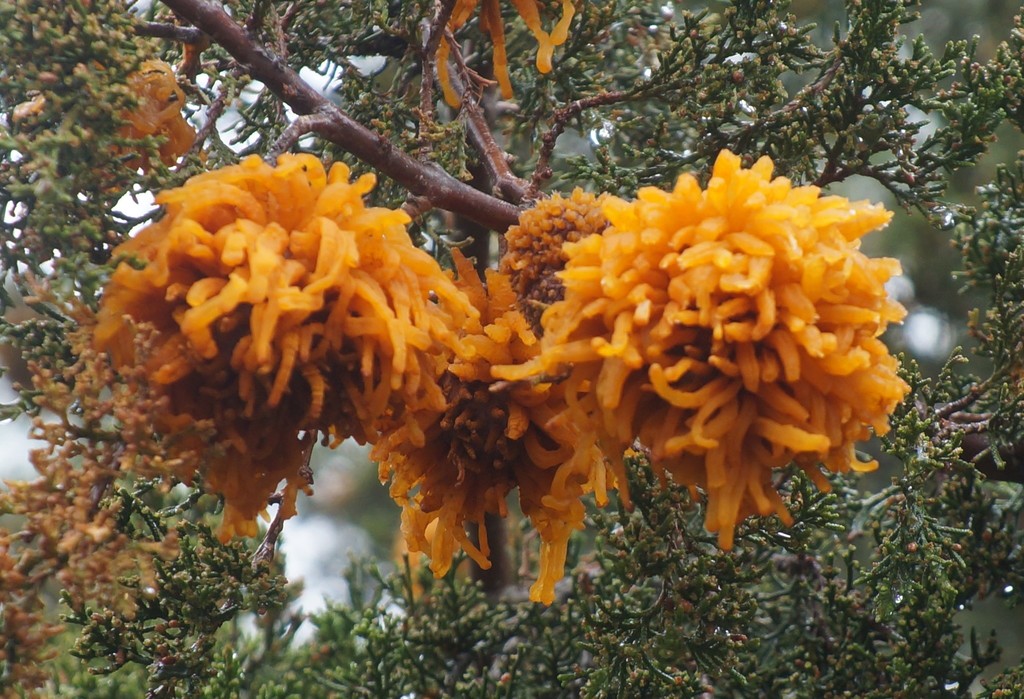Remember that I am not in any way a lichen expert. This is just my notes of what I have had IDed for me over the years as I photograph lichens.
Tree Trunk Lichens (roughly in the order that I learned them)
Common Greenshield (Flavoparmelia caperata):
- Big, greenish circles, often 6 inches in diameter but varying in size.
- Greener than most other lichen
- No discs (apothecia)
Rough Speckled Shield Lichen (Punctelia rudecta):
- big, grayish circles, often 6 inches in diameter but varying in size.
- White dots all over the lichen.
- Center is rougher and browner than edge, with tiny lumps (isidia)
Candleflame Lichen (Candelaria concolor):
- yellow specks
- looking closely, they always have an actual thallus, branching leaf-like form
- not a particular shape, just patches that blend into one another
Rosette lichen (Physcia millegrana)
- lots of little gray-green flakes.
- no real shape, but they cover much of the background of many tree trunks.
- Often has round reporductive discs (apothecia)
Orange-Cored Shadow Lichen (Phaeophyscia rubropulchra):
- very dark gray, hard to see against most bark
- largely oval in outline but generally two inches or less in diameter
- very divided thallus
- orange if you break it open
Hammered Shield Lichen (Parmelia sulcata):
- Gray colored, generally smaller than common or rough speckled.
- surface covered in dents, somewhat like it's been beaten with a ball-peen hammer
- Branches in thallus much narrower than in the big shield lichens.
Smooth bark lichens:
Common Script Lichen (Graphis scripta)
- white oval patches (often wider than tall)
- dark squiggles (actually reproductive discs, apothecia, but not disc shaped)
- most often on hornbeam
Common button lichen (Buellia erubescens):
- small, oval, light gray or bark colored patches with scattered black warts
Rim lichens (Lecanora spp.):
- generally gray-green oval patches.
- obvious reproductive discs (apothecia) with rims the same color as the lichen
- the center of the disk roughly indicates the species: waxy yellow = mealy, dark brown = bumpy, pink and small = pink-eyed, white = frosted. This is not entirely reliable nor are these the only rim lichens.
Mapledust Lichen (Lecanora thysanophora):
- almost never has disks
- much lighter colored rim around the whole lichen
- generally on maples.
- more common north of NJ
Lichens on branches (all of the bark lichens, plus):
Common Ruffle lichen:
- edge of thallus turned up and ruffly
- edge has conspicuous black "eyelashes" (rhyzomes)
- edge often mealy looking
Star Rosette Lichen (Physcia stellaris) (can be on trunk as well):
- gray-white thallus.
- branches are somewhat tubular looking and smooth
- often has reproductive disks (apothecia) in a darker color.
Strap lichen (Ramalina americana)
- bushy but with strap like branches
- reproductive discs big and balanced on edges of leaf like a plate on the edge of a board.
- not commonly seen except on recently planted nursery trees.
Bushy beard lichen (Usnea strigosa)
- bushy with stringy branches
- each branch has tiny branchlets at ninety degree angles to it all over
- reproductive discs big and balanced on edges of leaf like a plate on the edge of a board.
- not commonly seen except on recently planted nursery trees.
Lichens on fences, or on the bases of trees (most of the above lichens plus)
British soldier lichens (Cladonia cristatella and C. floerkeana)
- green "matchsticks" with red tips
- base made up of gray-green flakes
- C. cristatella is not as bumpy on the "sticks" as C. floerkana
Common Powderhorn (Cladonia coniocraea)
- just the green sticks, with no red tips
- base is gray-green flakes
- at the base of trees almost all blue-green or gray-green flakes are this species.
- there are many less common Cladonia species on horizontal wood, often with cups at tips of sticks
Lichens on bare ground:
Turban cap lichen (Cladonia peziziformis)
- gray-green sticks with big, pinkish-brown caps
- sometimes also grows on decaying cement
Dixie Reindeer Lichen (Cladonia subtenuous)
- like a tangled mass of yarn
- branches fork in "y"s which then fork in "y"s etc.
- greener and more common than the other reindeer lichen
Gray Reindeer Lichen (Cladonia rangiferina)
- tangled mass
- grayer and not as clearly "y"-branched as Dixie
- almost only ever found on coastal plane, less common.
Lichen on sidewalks (and gravestones)
Sidewalk Firedot
-circular collections of bright orange or red-orange discs.
Note the various candleflame, goldspeck, and gold dust lichens can also be on sidewalks, as can various crusty green ones that I can't identify
Lichens on Rocks
Smokey-eyed Boulder Lichen (Porpidia albocaerulescens)
- oval splashes of white or light
- covered in reproductive discs, especially in the center
- discs are waxy gray with black rims.
Rock Greenshield (Flavoparmelia biltmorensis)
- like a common greenshield on rock
- center is noticeably more brown than edges
- smoother looking than common greenshield
Note that common greenshield can also grow on rocks
note that there are a lot more lichens that I cannot yet ID, especially on rocks.























































